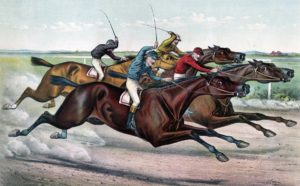What was the St. Albans Grand Steeplechase?
As the name suggests, the St. Albans Grand Steeplechase was a steeplechase run over a variety of cross-country courses in the vicinity of St. Albans, Hertfordshire. The brainchild of local hotelier Thomas Coleman, the St. Albans Grand Steeplechase was staged, with no little success, between 1830 and 1839. The inaugural running took place across the county border in Bedfordshire, over a 4¼-mile course between St. Mary’s Parish Church in Harlington and the obelisk in Wrest Park, Silsoe.
Thereafter, the St. Albans Grand Steeplechase was centred on Nomansland Common, so-called because it lies across two parishes, Sandridge and Wheathampstead, north of St. Albans. By 1834, the St. Albans Grand Steeplechase had become a race of national importance. Inspired by its success, Liverpudlian entrepreneur William Lynn, who had been staging Flat racing at Aintree Racecourse since 1829, staged his own race, originally known as the Liverpool Grand Steeplechase, in 1836.
That race would, of course, become the Grand National, but would not officially be known as such until 1847. Heavily indebted, Coleman staged the final St. Albans Grand Steeplechase – which was, by all accounts a shambolic affair – in 1839. Meanwhile, the connection of Liverpool to the major cities of Manchester, Birmingham and London by rail gave the Liverpool Grand Steeplechase national appeal and it effectively replaced the St. Albans Grand Steeplechase in the racing calendar.
 The history of the Grand National dates back to 1839, while the Cheltenham Gold Cup and Champion Hurdle were inaugurated in 1924 and 1927, respectively. However, in the best part of a century since the three races have co-existed, no horse has ever won all three. In fact, in all that time, just two horses have won the Cheltenham Gold Cup and Grand National and just one has won the Champion Hurdle and Cheltenham Gold Cup.
The history of the Grand National dates back to 1839, while the Cheltenham Gold Cup and Champion Hurdle were inaugurated in 1924 and 1927, respectively. However, in the best part of a century since the three races have co-existed, no horse has ever won all three. In fact, in all that time, just two horses have won the Cheltenham Gold Cup and Grand National and just one has won the Champion Hurdle and Cheltenham Gold Cup.